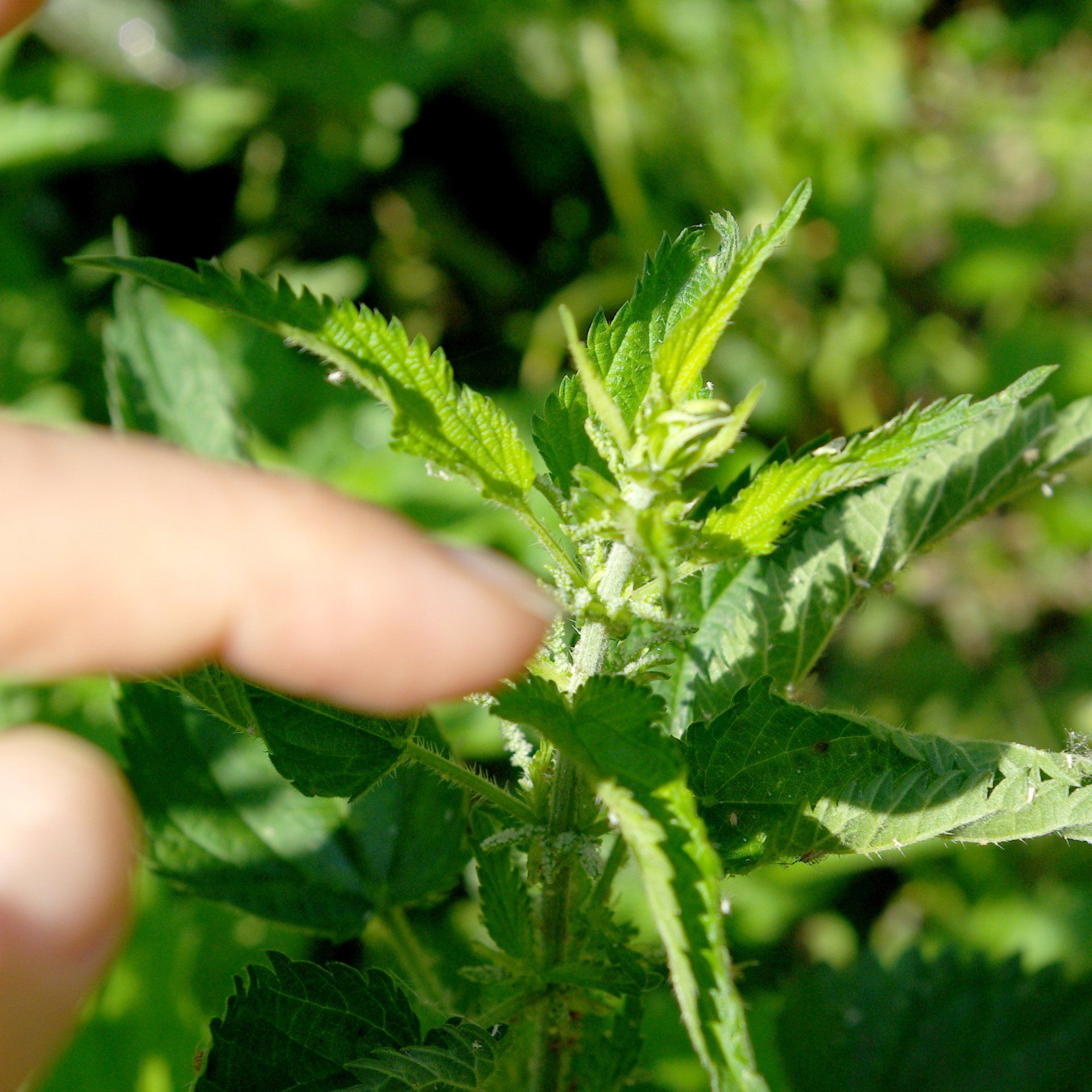do it yourself.
Start making nettle ointment yourself
... OR ANOTHER OALF OF FRESH HERBS ...
You can make ointment in many ways. Below I describe a simple recipe, as I make it myself. The base ointment is made of beeswax and oil in a ratio of 1: 9. For example: 90 grams of organic Sunflower oil and 10 grams of Beeswax together make up about 115 ml of ointment.
Then of course you need Nettle. Only use the fresh buds of the Stinging Nettle. Pick them (carefully) on a dry day in a clean place and don't pick more than you need. For a small jar of ointment, that's really no more than a few nice buds.
Heat the beeswax in a bain-marie and when it has melted, slowly add the oil. Stir this well. Then cut the Nettle into small pieces (about 1 cm). Make sure the herb is completely covered with oil and that the oil is saturated. Heat this now for a total of about 10 to 15 hours. Stir it regularly and let it solidify again and again. You can heat it for an hour every day or a few hours a day, it doesn't matter much. Then sieve it as hot (and therefore liquid) as possible with a (cheese) cloth. Squeeze it a little more, but not too hard because then moisture will come with it. If you sieve it in a metal jug or container, you can keep it liquid a little longer because the metal stays warm for a long time. It is easier to donate. Finally, pour it into a (brown) glass jars or tubes. Stick a label on it with the content and date of creation.
Other herbs to make ointment with are:
• Smelly Celandine | for dry eczema, dirty skin and warts
• Marigold | purifying and healing for all kinds of skin conditions
• Comfrey | for bruises, sprains, bumps and bruises
• Chamomile | soothing and healing for the skin
• Violet Tricolor | soothing and healing for the skin | wet and dry eczema
• Plantain (narrow) | for cuts, stab wounds and insect bites
• etc.
Have fun creating and if you have any questions about it please let me know! Cindy

First aid for puncture-scrape itching
Nettle ointment helps very well with itching or sting from a mosquito or the nettle itself! And also with abrasions. Especially dirty wounds. And wet eczema.
Well ... you can actually use it for a lot!
In our home there is always a lick of nettle ointment on the (washed and possibly disinfected with colloidal silver) abrasion before the plaster is applied. When the wound is clean, you can also use Calendula ointment to heal the skin.
List of services
-
Nettle VultureListing 1Nettle vulture is a natural food source for plants and a pesticide against lice, fungi and uninvited guests. I will tell you here what I have used it for in recent years and how you can make it very simple yourself.
-
Nettle OintmentListing 2Nettle sting, mosquitoes, bees and wasp sting, all stings, all burns, acne, dirty wounds ... smear it with your homemade nettle ointment. Difficult? Not at all!
-
St. John's OilListing 3Making delicious oil yourself doesn't have to be complicated at all. The moment of harvesting your herbs is especially important and the quality of your oil and the amount of solar power that you have at your disposal.
-
Herbal tinctureListing 4A tincture is an infusion of the herbs. The active substances or constituents are absorbed by the alcohol. This gives you a mother tincture that can be kept for a very long time (years).
-
Herbal Cough SyrupUche, uche uche ... You just make a cough syrup from herbs yourself. Beneficial and delicious!
-
Iced teaMaking iced tea yourself is actually too simple for words. You make strong tea from herbs / tea that you like, let it cool down, add sugar (preferably not) or honey (better) and a handful of ice cubes.
-
Flower butter
You only need a few ingredients for this simple flower butter. Basically, you can already get started with a packet of real butter at room temperature and some beautifully colored flowers from your garden.
-
Elderflower waterUhhh ... this one is going to be really short. And powerful. Because Elderflower is resistance and makes you stronger from within. It is a blessing for starting flu symptoms such as a sore throat and cough.
-
Spring TeaSpring is the time of the year to drain the remnants left in your body from the winter. And that can be done very simply with herbs. And maybe they (or some of them) are just growing in your own garden.
-
Natural DeodorantOh how happy I am with this recipe for making your own deodorant! So simple and it works great! Completely mess-free and super cheap.
-
Anti-Mosquito
You can distract them by placing strongly scented plants around your patio. Plants like Lavender, Lemon Balm, Lemon Geranium, Sage and Rosemary.



